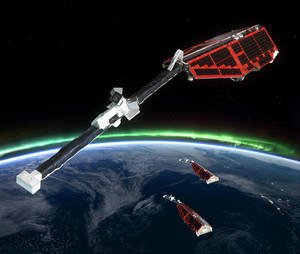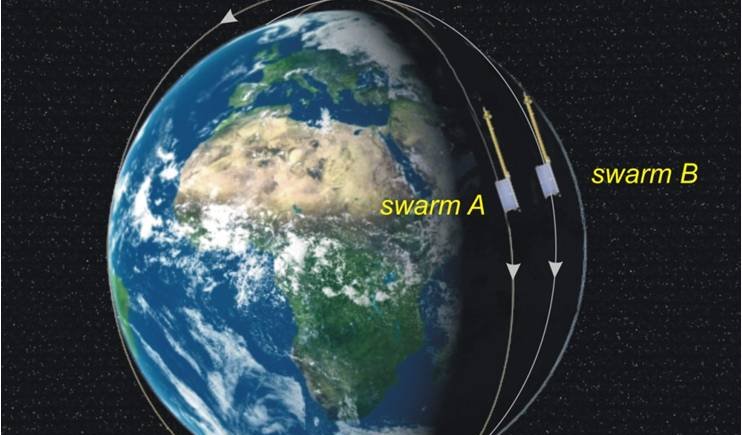Swarm Mission Overview
Swarm is ESA's first constellation mission for Earth Observation (EO). This mission is operated by ESA's European Space Operations Centre (ESOC), in Germany, via the primary ground station in Kiruna, Sweden. This mission consists of the three identical Swarm satellites (A, B, and C), which were launched on 22 November 2013 into a near-polar orbit.
The final constellation of the mission was achieved on 17 April 2014. Swarm A and C form the lower pair of satellites flying side by side (1.4° separation in longitude) at an altitude of about 470km (inclination angle is equal to 87.30°), whereas Swarm B is cruising at higher orbit of about 520 km (inclination angle is equal to 87.75°).
Detailed information on the Swarm orbit evolution and manoeuvres
Swarm Science Objectives
The five research objectives of the Swarm mission are:
- Studies of core dynamics, geodynamo processes, and core-mantle interaction;
- Mapping of the lithospheric magnetisation and its geological interpretation;
- Determination of the 3-D electrical conductivity of the mantle;
- Investigation of electric currents flowing in the magnetosphere and ionosphere;
- Magnetic Forcing of the Upper Atmosphere.
The malfunction of the "Midori-2" satellite in October 2003 was the latest in a series of radiation-induced satellite failures in a region in the southern hemisphere known as South Atlantic Anomaly due to the reduced magnetic field intensity.
While the earth magnetic field protects us from the continuous flow of charged particles, the solar wind, before it reaches the atmosphere, its dominant axial dipole component is currently decreasing at a rate presumably ten times faster than the one at which it would naturally decay. It has decreased by nearly 8% over the last 150 years, however, in some regions, as the South Atlantic Anomaly, the field has decreased by up to 10% during the last 20 years.
Understanding how this weakening shield is going to evolve in the future will have to be addressed by a better mapping of the time-variable geomagnetic field. This will provide new insights into field generation and diffusion, and mass and wave motions in the fluid core.
The increase in resolution of the lithospheric magnetism will tell us about both the history of the global field and geological activity and will serve as a bridge between our knowledge of the lower crust from previous satellite missions and our knowledge of the upper crust from aeromagnetic surveys. First global 3-D images of the electrical conductivity in the mantle could help to understand mantle properties and dynamics.
Finally, the magnetic field is of primary importance for the external environment of the Earth, providing information about the coupled Sun-Earth system.
Swarm liefert Beiträge zu:
- Erdmagnetfeld
- Ionosphäre, Thermosphäre, Weltraumwetter
- Geodäsie, Geowissenschaften




